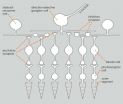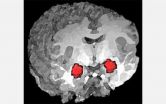(Press-News.org) NEW BRUNSWICK, N.J. – Rutgers researchers have identified a class of high-strength metal alloys that show potential to make springs, sensors and switches smaller and more responsive.
The alloys could be used in springier blood vessel stents, sensitive microphones, powerful loudspeakers, and components that boost the performance of medical imaging equipment, security systems and clean-burning gasoline and diesel engines.
While these nanostructured metal alloys are not new – they are used in turbine blades and other parts demanding strength under extreme conditions – the Rutgers researchers are pioneers at investigating these new properties.
"We have been doing theoretical studies on these materials, and our computer modeling suggests they will be super-responsive," said Armen Khachaturyan, professor of Materials Science and Engineering in the Rutgers School of Engineering. He and postdoctoral researcher Weifeng Rao believe these materials can be a hundred times more responsive than today's materials in the same applications.
Writing in the March 11 issue of the journal Physical Review Letters, the researchers describe how this class of metals with embedded nanoparticles can be highly elastic, or "springy," and can convert electrical and magnetic energy into movement or vice-versa. Materials that exhibit these properties are known among scientists and engineers as "functional" materials.
One class of functional materials generates an electrical voltage when the material is bent or compressed. Conversely, when the material is exposed to an electric field, it will deform. Known as piezoelectric materials, they are used in ultrasound instruments; audio components such as microphones, speakers and even venerable record players; autofocus motors in some camera lenses; spray nozzles in inkjet printer cartridges; and several types of electronic components.
In another class of functional materials, changes in magnetic fields deform the material and vice-versa. These magnetorestrictive materials have been used in naval sonar systems, pumps, precision optical equipment, medical and industrial ultrasonic devices, and vibration and noise control systems.
The materials that Khachaturyan and Rao are investigating are technically known as "decomposed two-phase nanostructured alloys." They form by cooling metals that were exposed to high temperatures at which the nanosized particles of one crystal structure, or phase, are embedded into another type of phase. The resulting structure makes it possible to deform the metal under an applied stress while allowing the metal to snap back into place when the stress is removed.
These nanostructured alloys might be more effective than traditional metals in applications such blood vessel stents, which have to be flexible but can't lose their "springiness." In the piezoelectric and magnetorestrictive components, the alloy's potential to snap back into shape after deforming – a property known as non-hysteresis – could improve energy efficiency over traditional materials that require energy input to restore their original shapes.
In addition to potentially showing responses far greater than traditional materials, the new materials may be tunable; that is, they may exhibit smaller or larger shape changes and output force based on varying mechanical, electrical or magnetic input and the material processing.
The researchers hope to test the results of their computer simulations on actual metals in the near future.
INFORMATION:
The Rutgers team collaborated with Manfred Wittig, professor of Materials Science and Engineering at the University of Maryland. Their research was funded by the National Science Foundation and the U.S. Department of Energy.
Rutgers researchers identify materials that may deliver more 'bounce'
Springy nanostructured metals hold promise of making engines, medical equipment, security systems more efficient and effective
2011-03-10
ELSE PRESS RELEASES FROM THIS DATE:
When leukemia returns, gene that mediates response to key drug often mutated
2011-03-10
(MEMPHIS, Tenn. – March 9, 2011) Despite dramatically improved survival rates for childhood acute lymphoblastic leukemia (ALL), relapse remains a leading cause of death from the disease. Work led by St. Jude Children's Research Hospital investigators identified mutations in a gene named CREBBP that may help the cancer resist steroid treatment and fuel ALL's return.
CREBBP plays an important role in normal blood cell development, helping to switch other genes on and off. In this study, researchers found that 18.3 percent of the 71 relapsed-ALL patients carried alterations ...
Gene variant influences chronic kidney disease risk
2011-03-10
A team of researchers from the United States and Europe has identified a single genetic mutation in the CUBN gene that is associated with albuminuria both with and without diabetes. Albuminuria is a condition caused by the leaking of the protein albumin into the urine, which is an indication of kidney disease.
The research team, known as the CKDGen Consortium, examined data from several genome-wide association studies to identify missense variant (I2984V) in the CUBN gene. The association between the CUBN variant and albuminuria was observed in 63,153 individuals with ...
New microscope decodes complex eye circuitry
2011-03-10
VIDEO:
Ganglion cells preferentially form synapses with those amacrine cells whose dendrites run in the direction opposite -- seen from the ganglion cell - to the preferred direction of motion (amacrine...
Click here for more information.
The sensory cells in the retina of the mammalian eye convert light stimuli into electrical signals and transmit them via downstream interneurons to the retinal ganglion cells which, in turn, forward them to the brain. The interneurons ...
Physicists measure current-induced torque in nonvolatile magnetic memory devices
2011-03-10
ITHACA, N.Y. - Tomorrow's nonvolatile memory devices – computer memory that can retain stored information even when not powered – will profoundly change electronics, and Cornell University researchers have discovered a new way of measuring and optimizing their performance.
Using a very fast oscilloscope, researchers led by Dan Ralph, the Horace White Professor of Physics, and Robert Buhrman, the J.E. Sweet Professor of Applied and Engineering Physics, have figured out how to quantify the strength of current-induced torques used to write information in memory devices ...
NASA and other satellites keeping busy with this week's severe weather
2011-03-10
Satellites have been busy this week covering severe weather across the U.S. Today, the GOES-13 satellite and NASA's Aqua satellite captured an image of the huge stretch of clouds associated with a huge and soggy cold front as it continues its slow march eastward. Earlier this week, NASA's Tropical Rainfall Measuring Mission satellite captured images of severe weather that generated tornadoes over Louisiana.
Today the eastern third of the U.S. is being buffered by a large storm that stretches from southeastern Minnesota east to Wisconsin and Michigan, then south through ...
International panel revises 'McDonald Criteria' for diagnosing multiple sclerosis
2011-03-10
International Panel Revises "McDonald Criteria" for Diagnosing MS -- Use of new data should speed diagnosis -- Publication coincides with MS Awareness Week
An international panel has revised and simplified the "McDonald Criteria" commonly used to diagnose multiple sclerosis, incorporating new data that should speed the diagnosis without compromising accuracy. The International Panel on Diagnosis of MS, organized and supported by the National MS Society and the European Committee for Treatment and Research in Multiple Sclerosis, was chaired by Chris H. Polman, MD, PhD ...
MIT scientists identify new H1N1 mutation that could allow virus to spread more easily
2011-03-10
CAMBRIDGE, Mass. -- In the fall of 1917, a new strain of influenza swirled around the globe. At first, it resembled a typical flu epidemic: Most deaths occurred among the elderly, while younger people recovered quickly. However, in the summer of 1918, a deadlier version of the same virus began spreading, with disastrous consequence. In total, the pandemic killed at least 50 million people — about 3 percent of the world's population at the time.
That two-wave pattern is typical of pandemic flu viruses, which is why many scientists worry that the 2009 H1N1 ("swine") flu ...
New study proves the brain has 3 layers of working memory
2011-03-10
Researchers from Rice University and Georgia Institute of Technology have found support for the theory that the brain has three concentric layers of working memory where it stores readily available items. Memory researchers have long debated whether there are two or three layers and what the capacity and function of each layer is.
In a paper in the March issue of the Journal of Cognitive Psychology, researchers found that short-term memory is made up of three areas: a core focusing on one active item, a surrounding area holding at least three more active items, and a ...
Giving children the power to be scientists
2011-03-10
Children who are taught how to think and act like scientists develop a clearer understanding of the subject, a study has shown.
The research project led by The University of Nottingham and The Open University has shown that school children who took the lead in investigating science topics of interest to them gained an understanding of good scientific practice.
The study shows that this method of 'personal inquiry' could be used to help children develop the skills needed to weigh up misinformation in the media, understand the impact of science and technology on everyday ...
Researchers selectively control anxiety pathways in the brain
2011-03-10
A new study sheds light--both literally and figuratively--on the intricate brain cell connections responsible for anxiety.
Scientists at Stanford University recently used light to activate mouse neurons and precisely identify neural circuits that increase or decrease anxiety-related behaviors. Pinpointing the origin of anxiety brings psychiatric professionals closer to understanding anxiety disorders, the most common class of psychiatric disease.
A research team led by Karl Deisseroth, associate professor of psychiatry and behavioral sciences and bioengineering, identified ...
LAST 30 PRESS RELEASES:
New circoviruses discovered in pilot whales and orcas from the North Atlantic
Study finds increase in risk of binge drinking among 12th graders who use 2 or more cannabis products
New paper-based technology could transform cancer drug testing
Opioids: clarifying the concept of safe supply to save lives
New species of tiny pumpkin toadlet discovered in Brazil highlights need for conservation in the mountain forests of Serra do Quiriri
Reciprocity matters--people were more supportive of climate policies in their country if they believed other countries were making significant efforts themselves
Stanford Medicine study shows why mRNA-based COVID-19 vaccines can cause myocarditis
Biobanking opens new windows into human evolution
Sky-high smoke
AI tips off scientists to new drug target to fight, treat mpox
USC researchers develop next-generation CAR T cells that show stronger, safer response in animal models
New study reveals Industrial Revolution’s uneven health impacts across England
Vine-inspired robotic gripper gently lifts heavy and fragile objects
Fingerprint of ancient seafarer found on Scandinavia’s oldest plank boat
Lunar soil analyses reveal how space weathering shapes the Moon’s ultraviolet reflectance
Einstein’s theory comes wrapped up with a bow: astronomers spot star “wobbling” around black hole
Danforth Plant Science Center to lead multi-disciplinary research to enhance stress resilience in bioenergy sorghum
Home-delivered groceries improve blood sugar control for people with diabetes facing food insecurity
MIT researchers identified three cognitive skills we use to infer what someone really means
The Iberian Peninsula is rotating clockwise according to new geodynamic data
SwRI, Trinity University to study stable bacterial proteins in search of medical advances
NIH-led study reveals role of mobile DNA elements in lung cancer progression
Stanford Medicine-led study identifies immune switch critical to autoimmunity, cancer
Research Alert: How the Immune System Stalls Weight Loss
Glucagon-like peptide 1 receptor agonist use and vertebral fracture risk in type 2 diabetes
Nonadherence to cervical cancer screening guidelines in commercially insured US adults
Contraception and castration linked to longer lifespan
An old jeweler’s trick could unlock next-generation nuclear clocks
Older age, chronic kidney disease and cerebrovascular disease linked with increased risk for paralysis and death after West Nile virus infection
New immune role discovered for specialized gut cells linked to celiac disease
[Press-News.org] Rutgers researchers identify materials that may deliver more 'bounce'Springy nanostructured metals hold promise of making engines, medical equipment, security systems more efficient and effective



